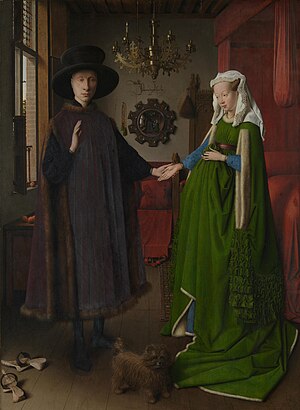All AP Art History Resources
Example Questions
Example Question #171 : 2 D Art

Pictured above is the Arnolfini Portrait, and can be found at the Website of National Gallery, London.
The painting displays symbols of __________.
charity
wealth
love
piety
wealth
Both figures are richly dressed, adorned with the latest fashions of the time, which is very much a symbol of wealth and status. While it is a marriage portrait, love has little enough to do with marriage in the Northern Europe of the fifteenth century.
Example Question #172 : 2 D Art

Pictured above is the Arnolfini Portrait, and can be found at the Website of National Gallery, London.
The function of the painting is to __________.
make the painter famous
demonstrate piety
honor a marriage contract
celebrate a new life
honor a marriage contract
The work depicts a newlywed couple, and it is meant to honor their marriage through artistic depiction.
Example Question #11 : Answering Other Questions About Fourteenth Through Sixteenth Century 2 D Art
Renaissance art made a dramatic departure from medieval art by __________.
using fewer and less rich colors
None of the other answers
deemphasizing classical subjects
putting more focus on religious subjects
using more realistic depictions of the human form
using more realistic depictions of the human form
During the Renaissance, with a renewed focus on classical art and scientific understanding, visual arts underwent a significant change. In particular, religious themes dwindled in importance in comparison to classical subjects, and deeper, more varied colors were used to represent more realistic depictions of the human form.
Example Question #171 : Ap Art History
What figure from Greek mythology is prominently featured in Sandro Botticelli's most famous work?
Hera
Mars
Hercules
Venus
Zeus
Venus
Sandro Botticelli's The Birth of Venus is one of the signature paintings of Early Renaissance art from Italy, and as such deals with many themes prominent in the era. Botticelli chose the ancient goddess of love, appearing nude and fully formed from the ocean on a clam shell, instead of a Christian theme. Additionally, the picture's symbolism and color focus more on Platonic ideals than the Christian symbolism that was so prevalent in late Medieval art.
Example Question #171 : Ap Art History
All of the following statements about European humanism and its influence on visual art of the Fourteenth and Fifteenth Centuries are true except _____________.
it promoted a revival of Classical Antiquity, particularly the study of Latin literature, and its proponents sought to consciously emulate what were thought to be the Roman civic virtues
it was reinforced by the growth of the mendicant orders, which renounced all worldly goods and committed themselves to ministering to the people
humanism was a philosophical system based primarily on the ten books of Plato’s Republic
humanism was a code of civil conduct, a theory of education, and a scholarly discipline concerned with human values that signified a departure from medieval scholasticism
the art of this movement is characterized by a naturalistic approach based on observation, an understanding of how to depict spatial depth and bodily mass, and an exaltation of the human form as the height of beauty
humanism was a philosophical system based primarily on the ten books of Plato’s Republic
While Plato's Republic is a work of literature from Classical Antiquity, it is not so largely influential on the overall movement of Renaissance Humanism in literature and in art to be accurately described as the philosophical system at Humanism's core. Humanism was too broad a movement to have its fundamental basis attributed to any one work.
Example Question #102 : Fourteenth Through Sixteenth Century 2 D Art
The fifteenth century invention of the printing press with moveable type saw which of the following developments in the visual arts?
The invention of the woodblock method of printmaking for images.
A rise in the popularity of prints used to accompany text and a subsequent explosion in demand for relief and intaglio prints.
A market decrease in price and popularity for two-dimensional art of all mediums including oil paintings, due largely to the inexpensive nature and widespread availability of prints.
A decrease in the popularity of intaglio printmaking.
A decrease in the popularity of so-called Japan paper and China paper in favor of uniquely European papermaking techniques, which avoided the use of cotton or linen fibers.
A rise in the popularity of prints used to accompany text and a subsequent explosion in demand for relief and intaglio prints.
The invention of the printing press gave way to an explosion in the manufacturing of books, many of which required illustrations to accompany the written word. This allowed for great expansion in the arts of printmaking and greatly increased the popularity of the medium, with its methods such relief (woodblock) printing, intaglio, etc.
Example Question #103 : Fourteenth Through Sixteenth Century 2 D Art
Near the end of the Italian High Renaissance, a unique artistic style emerged. It focused on asymmetry, unnatural elongation or exaggeration of human characteristics, and tension within the composition. Although this style lasted less than a century in Italy, its adoption in other, more northern European countries lasted well into the seventeenth century.
What artistic style is the above paragraph describing?
Rococo
Realism
Baroque art
Romanticism
Mannerism
Mannerism
Mannerism lasted in Italy from the 1520s until the 1580s, but was practiced for a much longer amount of time in European countries north of Italy. Mannerist paintings portray subjects with purposefully elongated proportions and stylized poses. It was a step away from the harmonious, symmetrical, and rational subjects of Renaissance art.
Example Question #104 : Fourteenth Through Sixteenth Century 2 D Art
It has been speculated that the Bubonic Plague, also known as the Black Death, which occurred during the mid-14th century and claimed the lives of 30% to 60% of Europeans, sparked which artistic and scientific movement in its aftermath?
Neoclassicism
The Renaissance
Romanticism
Rococo
None of these
The Renaissance
It is speculated that in the aftermath of the Bubonic Plague, the citizens of Europe, and especially Italy, which was particularly devastated by the Plageu, began to think of life, spirituality, art, science, and the afterlife in a new way. This particularly traumatic event caused a social and economic upheaval in many parts of Europe, which changed the way of life and opportunities of many citizens.
These social, economic, religious and scientific changes in European culture may have sparked what is now known as the Renaissance.
Example Question #105 : Fourteenth Through Sixteenth Century 2 D Art

A work of art such as the Annunciation Triptych by the Workshop of Robert Campin was traditionally displayed __________________.
outside of a city hall
on a church's altar
in a private home
in a royal reception room
on a church's altar
The Annunciation Triptych, also known as the Mérode Altarpiece, is typical of a late medieval, early renaissance religious work of art that was designed to fit across the altar in a church. Usually paid for and commissioned by the civic leaders, such a work of art both held religious significance and demonstrated the wealth and prestige of the city. Robert Campin, and his Workshop, would have created the piece both as a matter of artistic skill and to show religious meaning.
Image is in the public domain, accessed through Wikipedia Media Commons: https://commons.wikimedia.org/wiki/File:Robert_Campin_-_Triptych_with_the_Annunciation,_known_as_the_%22Merode_Altarpiece%22_-_Google_Art_Project.jpg
Example Question #106 : Fourteenth Through Sixteenth Century 2 D Art

Based on the style of the work, it was created in _________________.
Italy
Flanders
Spain
England
Flanders
Two significant, but very separate, movements pushed European painting forward in the fifteenth century. One was the Italian Renaissance, which focused on new methods of perspective and light. By contrast, Early Netherlandish Painting, centered in Flanders and represented by the Annunciation Triptych, used traditional methods of representation and posing, but made technical innovations in color and drawing that created more sharply defined and exquisite paintings. While the two would begin to learn from each other by the sixteenth century, Northern and Southern Europe continued to have separate traditions and styles in painting.
Image is in the public domain, accessed through Wikipedia Media Commons: https://commons.wikimedia.org/wiki/File:Robert_Campin_-_Triptych_with_the_Annunciation,_known_as_the_%22Merode_Altarpiece%22_-_Google_Art_Project.jpg
Certified Tutor
All AP Art History Resources



